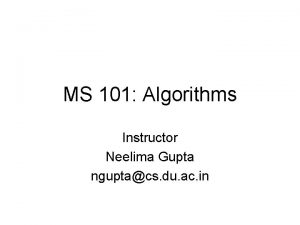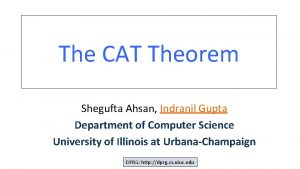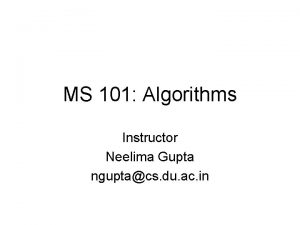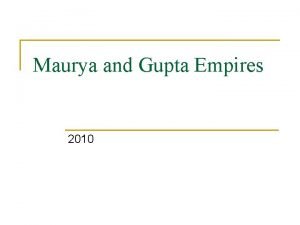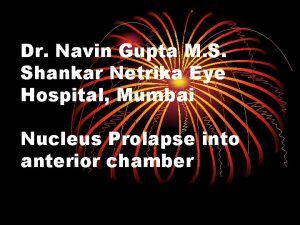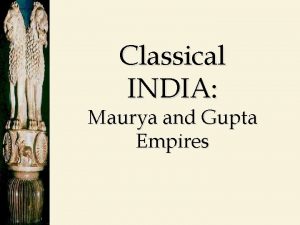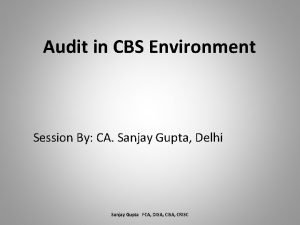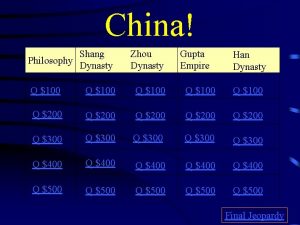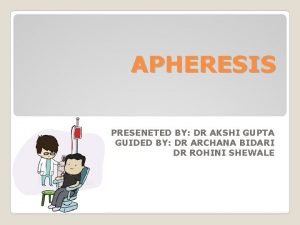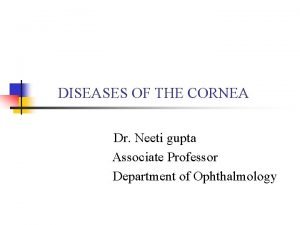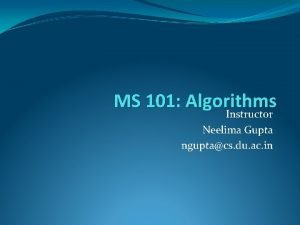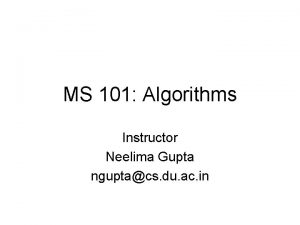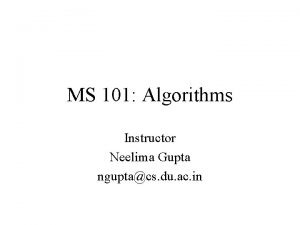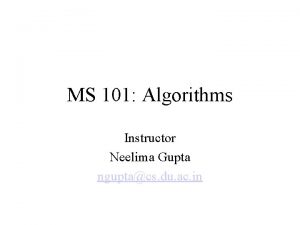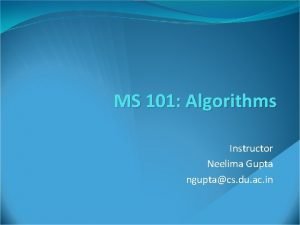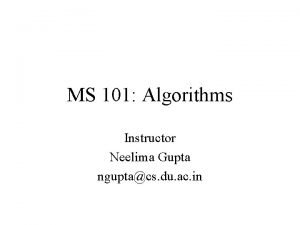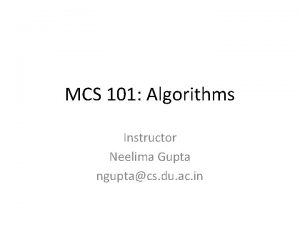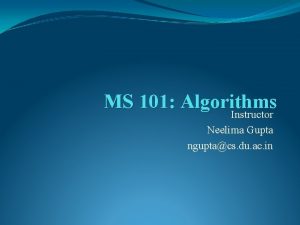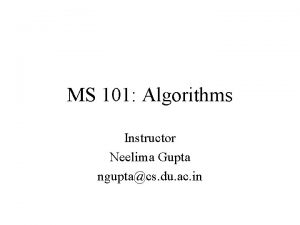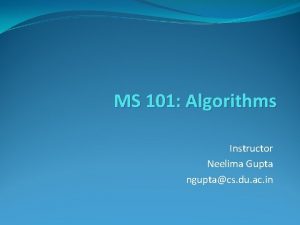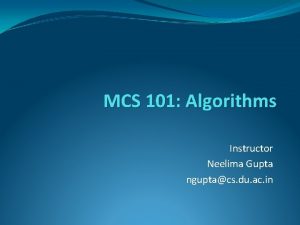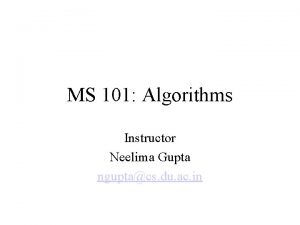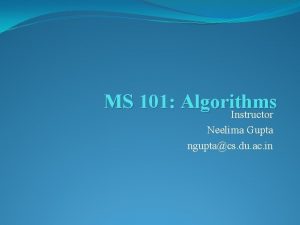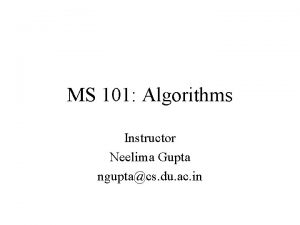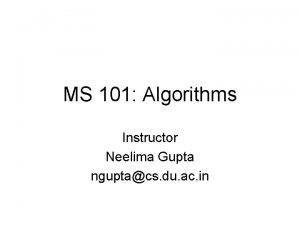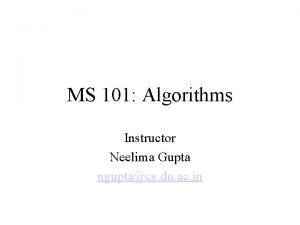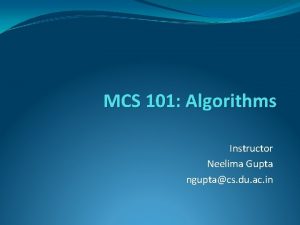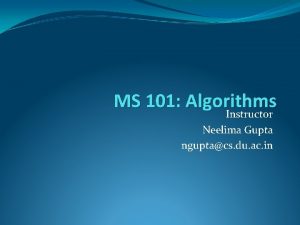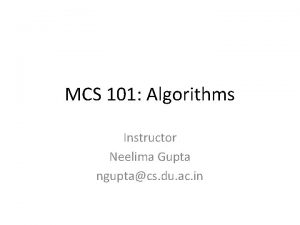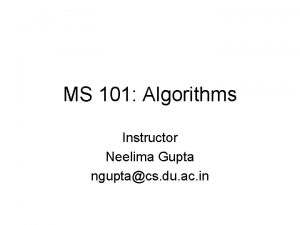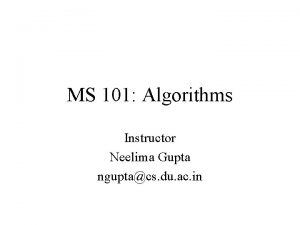MS 101 Algorithms Instructor Neelima Gupta nguptacs du




































































- Slides: 68

MS 101: Algorithms Instructor Neelima Gupta ngupta@cs. du. ac. in

Table of Contents • The Class P and NP • NP -- Completeness

Tractable vs Intractable • Some problems are intractable: as they grow large, we are unable to solve them in reasonable time • What constitutes reasonable time? Standard working definition: polynomial time – On an input of size n the worst-case running time is O(nk) for some constant k – Polynomial time: O(n 2), O(n 3), O(1), O(n lg n) – Not in polynomial time: O(2 n), O(n!)

Polynomial-Time Algorithms • Are some problems solvable in polynomial time? – Of course: every algorithm we’ve studied provides polynomial-time solution to some problem – We define P to be the class of problems solvable in polynomial time • Are all problems solvable in polynomial time? – No: Turing’s “Halting Problem” is not solvable by any computer, no matter how much time is given – Such problems are clearly intractable, not in P

Hamiltonian Cycle Problem – A hamiltonian cycle of an undirected graph is a simple cycle that contains every vertex – The hamiltonian-cycle problem: given a graph G, find a hamiltonian cycle in it? We’ll see later the problem is recast differently.

Copyright © The Mc. Graw-Hill Companies, Inc. Permission required for reproduction or display.

A naïve algorithm • List all permutations of the vertices and see if it forms a HC. • What is its Running time?

P and NP • As mentioned, P is set of problems that can be solved in polynomial time • NP (nondeterministic polynomial time) is the set of problems that can be solved in polynomial time by a nondeterministic computer – What the hell is that?

Nondeterminism • Think of a non-deterministic computer as a computer that magically “guesses” a solution, then has to verify that it is correct – If a solution exists, computer always guesses it – One way to imagine it: a parallel computer that can freely spawn an infinite number of processes • Have one processor work on each possible solution • All processors attempt to verify that their solution works • If a processor finds it has a working solution – So: NP = problems verifiable in polynomial time – We’ll define this notion more formally later.

HCP • Solution is verifiable in Polynomial Time. • Given sloution : a sequence of vertices. . let it be : v 1, v 2, …vn, v 1…for all I = 1, n check whethere is an edge (vi, vi+1) – With adjacency list representation this takes O(V) time for each edge. . total O(V 2) – polynomial – With incidency matrix, this takes O(1) time for each edge. . total O(V) – polynomial Hence HCP is in NP

Other Examples : 1. HCP : Given a graph G, does it have a HC in it? 2. Clique : – – OPT : find the largest Clique in a given graph CLIQUE(G, k) : Given G, does there exist a clique of size equal to k in G? 3. Vertex Cover : A VC of an undirected graph is a subset V’ of V such for all edges (u, v) either u or v or both are in V’. . Informally all the edges are covered by the subset V’. – – OPT : find a VC of minimum size. VERTEX-COVER(G, k) : Does G contain a VC of size k?

Clique is in NP

VC is in NP

Decision Problems Vs Optimization Problem • Most of the problems in NP are either decision problems or optimization problems. • In fact, most of the optimization problems can be recast as decision problems and it can be shown that optimization problems are at least as hard as their decision counterpart.

Another Example : SHORTESTPATH problem • SHORTEST-PATH problem : Given a pair of vertices u and v, in an unweighted, undirected graph, find a shortest path between them. • Its decision problem is : – PATH(G, u, v, k) : Does there exist a path of length less than or equal to k between u and v in G? Clearly, if we can solve the optimization problem in polynomial time, then we can solve the decision problem in polynomial time by asking : Is the shortest path of length <= k? Clearly, answer to this Q is “yes” iff answer to the PATH problem is “yes”.

Example : SHORTEST-PATH problem contd. . But the converse may not be true (in general). This shows that the optimization problem is harder (or at least as hard as ) than the decision problem. • Hence, if we can show that PATH is hard, it follows that SHORTEST-PATH is hard.

Optimization Problems Vs Decision Problems • Optimization problems are harder than (at least as hard as ) their decision counter-part. • Thus we’ll concentrate only on decision problems, show that they are hard. • That the Optimization problems are hard follows.

Abstract formulation of a problem • An abstract problem Q is a relation on a set I of instances and a set S of solutions. • For eg : SHOREST PATHS(G, u, v) – I : instance set : set of triplets (G, u, v) – S : set of shortest paths between u and v in G.

An Aside: Terminology • What is the difference between a problem and an instance of that problem? • To formalize things, we will express instances of problems as strings – How can we express a instance of the hamiltonian cycle problem as a string? – We will see how do we do this a little while later. • To simplify things, we will worry only about decision problems with a yes/no answer

Abstract formulation of a decision problem • This formulation is more general than required. . it is for OPT problems. For the decision problems S = {0, 1} or {No, Yes}. • For Eg. PATH(G, u, v, k) – For an instance i = (G, u, v, k), PATH(i) = Yes if there is a path between u and v, of length <= k in G, else PATH(i) = No.

Formal Language framework • We say that an algorithm A accepts a string over {0, 1} if, given input x, the algorithm’s output on x, denoted by A(x), is 1. • The language accepted by an algorithm A is the set of strings – L = {x over {0, 1} : A(x) = 1), – That is the set of strings that A accepts. – Note A need not reject a string if x is not in L.

Formal Language framework • A language L is decided by an algorithm A if every string in L is accepted by A and every string not in A is rejected by A. • A language L is accepted in polynomial time by an algorithm A if, there exists a constant k such that, for every string x in L, of length(binary length) n, A accepts x in O(n^k) time. • Similarly, define decidability.

Formal Language framework • HCP = {<G> : G is Hamiltonian} : The language consists of the strings representing graphs that are Hamiltonian. The length of the string is Omega(|V| + |E|). – Any algorithm to accept HCP that runs in time polynomial in max{|V|, |E|} will be polynomial in the length of the string. • PATH = {<G, u, v, k> : G has a path of length <= k between u and v}. The length of the input string is Omega(|V| + |E| + log u + log v + log k) – Any algorithm to accept PATH that runs in time polynomial in max{|V|, |E|} will be polynomial in the length of the string.

Eg: Polynomial time acceptance • HCP • PATH • LATER

Verification Algorithm • A Verification Algorithm is defined to be a two-argument (say, x and y) algorithm A where x is an input string (or an instance of a problem) and y is another string called the certificate. A is said to verify an input string x if there exists a certificate y such that A(x, y) = 1. • The language verified by the verification algorithm is L = {x ε {0, 1}*: there exists y ε {0, 1}* such that A(x, y) = 1} Intuitively, an algorithm A verifies a language L if for any string x ε L, there is a certificate y that A can use to prove that x ε L. Moreover, if x does not belong to L, there must be no certificate that can fool A in to believing that x is in L.

• Example : – HCP : x = <G> , if G is indeed Hamiltonian there is a a sequence of vertices that forms a HC in G … y is this sequence. Given y(such a sequence), it can be verified in linear time whether it forms a HC. . i. e. this sequence can be used to verify that x is in HCP. Big Questions: Who gives me this certificate? If I know this certificate, haven’t I already solved the problem?

Class NP redefined • Answer to the 2 nd Q : Yes, Indeed. • A language belongs to NP iff there exists a 2 -input polynomial time algorithm A and constant c such that L = {x over {0, 1} : there exists a certificate y with |y| = O(|x|^c) such that A(x, y) = 1} • We say that the algorithm A verifies language L in polynomial time. • Hence HCP is in NP.

Other Examples • Clique is in NP • VC is in NP

Another Example • PATH : verifiable in polynomial time, hence is in NP.

Discussion on complexity classes • Is P NP? Why or why not?

Copyright © The Mc. Graw-Hill Companies, Inc. Permission required for reproduction or display.

NP - Completeness • The aim to study this class is not to solve a problem but to see how hard is a problem?

NP-Complete Problems • The NP-Complete problems are an interesting class of problems whose status is unknown – No polynomial-time algorithm has been discovered for an NP-Complete problem – No supra-polynomial lower bound has been proved for any NP-Complete problem, either • We call this the P = NP question – The biggest open problem in CS

NP-completeness • The theory of NP_completeness restricts its attention to decision problems only.

Reduction • The crux of NP-Completeness is reducibility – Informally, a problem P can be reduced to another problem Q if any instance of P can be “easily rephrased” as an instance of Q, the solution to which provides a solution to the instance of P • What do you suppose “easily” means? • This rephrasing is called transformation or reduction – Intuitively: If P reduces to Q, then if one can solve Q then one can solve P also, i. e. P is “no harder to solve” than Q or Q is at least as hard as P.

Reducibility • An example: – P: Given a set of Booleans, is at least one TRUE? – Q: Given a set of integers, is their sum positive? – Transformation: (x 1, x 2, …, xn) = (y 1, y 2, …, yn) where yi = 1 if xi = TRUE, yi = 0 if xi = FALSE • Another example: – Solving linear equations is reducible to solving quadratic equations • How can we easily use a quadratic-equation solver to solve linear equations?

Reducibility • Formally, We say a language L 1 (say corresponding to problem P) is polynomial time reducible to language L 2 (say corresponding to problem Q) denoted by L 1 p L 2, if there exists a polynomial time computable function f : {0, 1}* such that for all x in {0, 1}* x is in L 1 iff f(x) is in L 2. • The function f is called the reduction function and a polynomial time algorithm F that computes f is called a reduction algorithm.


L 1 p L 2 and L 2 in P implies L 1 is in P

NP - Complete • Problem P is said to be NPC if 1. P NP, and 2. Q p P Q NP • That is, the problem is in NP and every other problem in NP is polynomial time reducible to P so that P is at least as hard as any other problem in NP.

NP-Hard and NP-Complete • If P is polynomial-time reducible to Q, we denote this P p Q • Definition of NP-Hard and NP-Complete: – If all problems R NP are reducible to P, then P is NPHard – We say P is NP-Complete if P is NP-Hard and P NP • If P p Q and P is NP-Complete, Q is also NP- Complete ---- Very Important

Why Prove NP-Completeness? • Though nobody has proven that P != NP, if you prove a problem NP-Complete, most people accept that it is probably intractable • Therefore it can be important to prove that a problem is NP-Complete – Don’t need to come up with an efficient algorithm – Can instead work on approximation algorithms

Proving NP-Completeness • What steps do we have to take to prove a problem P is NP-Complete? – Pick a known NP-Complete problem Q – Reduce Q to P • Describe a transformation that maps instances of Q to instances of P, s. t. “yes” for P = “yes” for Q • Prove the transformation works • Prove it runs in polynomial time – Oh yeah, prove P NP (What if you can’t? )

The SAT Problem • One of the first problems to be proved NPComplete was satisfiability (SAT): – Given a Boolean expression on n variables, can we assign values such that the expression is TRUE? – Ex: ((x 1 x 2) (( x 1 x 3) x 4)) x 2 – Cook’s Theorem: The satisfiability problem is NPComplete • Note: Argue from first principles, not reduction • Proof: not here

Conjunctive Normal Form • Even if the form of the Boolean expression is simplified, the problem may be NP-Complete – Literal: an occurrence of a Boolean or its negation – A Boolean formula is in conjunctive normal form, or CNF, if it is an AND of clauses, each of which is an OR of literals • Ex: (x 1 x 2) ( x 1 x 3 x 4) ( x 5) – 3 -CNF: each clause has exactly 3 distinct literals • Ex: (x 1 x 2 x 3) ( x 1 x 3 x 4) ( x 5 x 3 x 4) • Notice: true if at least one literal in each clause is true

The 3 -CNF Problem • Thm 36. 10: Satisfiability of Boolean formulas in 3 -CNF form (the 3 -CNF Problem) is NP-Complete – Proof: Nope • The reason we care about the 3 -CNF problem is that it is relatively easy to reduce to others – Thus by proving 3 -CNF NP-Complete we can prove many seemingly unrelated problems NP-Complete

3 -CNF Clique • What is a clique of a graph G? • A: a subset of vertices fully connected to each other, i. e. a complete subgraph of G • The clique problem: how large is the maximum-size clique in a graph? • Can we turn this into a decision problem? • A: Yes, we call this the k-clique problem • Is the k-clique problem within NP?

Clique is in NP • CLIQUE = {<G, k>: G has a clique of size k} • For x = <G, k> in CLIQUE, does there exist a certificate y: |y| = polynomial in the length of x and a polynomial time algorithm that can use y to verify that x is in CLIQUE? – – Show the existence of y, Show that |y| = polynomial in the length of |x|, Give an algorithm that verifies x using y, Show that the algorithm runs in polynomial time in |y| and |x| and hence in polynomial time in the length of |x|. SO, FOUR STEPS TO SHOW THAT A PROBLEM IS IN NP

CLIQUE is in NPC • • 2 nd step to show that CLIQUE is in NPC is Pick up a problem known to be NPC and – – Transform (reduce) the known problem to CLIQUE 0 Give the transformation 1. 2. 3. Show that under the transformation : solution of known problem is yes => solution to CLIQUE is yes. Show that under the transformation : solution of CLIQUE is yes => solution of the known problem is yes. Show that the transformation can be done in time polynomial in the length of an instance of the known problem. SO, THREE STEPS TO REDUCE A KNOWN PROBLEM TO CLIQUE.

3 -CNF Clique • What should the reduction do? • A: Transform a 3 -CNF formula to a graph, for which a k-clique will exist (for some k) iff the 3 -CNF formula is satisfiable

3 -CNF Clique • The reduction: – Let B = C 1 C 2 … Ck be a 3 -CNF formula with k clauses, each of which has 3 distinct literals – For each clause put a triple of vertices in the graph, one for each literal – Put an edge between two vertices if they are in different triples and their literals are consistent, meaning not each other’s negation – Run an example: B = (x y z) ( x y z ) (x y z )

Copyright © The Mc. Graw-Hill Companies, Inc. Permission required for reproduction or display.

3 -CNF Clique • Prove the reduction works: – If B has a satisfying assignment, then each clause has at least one literal (vertex) that evaluates to 1 – Picking one such “true” literal from each clause gives a set V’ of k vertices. V’ is a clique (Why? ) – If G has a clique V’ of size k, it must contain one vertex in each triple (clause) (Why? ) – We can assign 1 to each literal corresponding with a vertex in V’, without fear of contradiction

Reduction takes polynomial time • Let there be n variables in the 3 -CNF with k clauses • Then, the input size is at least(>=) B = max{k, n} • Any algorithm at most(<=) polynomial in B is polynomial in the input size. • Creating 3 k vertices with no more than k^2 edges with n variables takes no more than max{k^2 max{log 3 k, log n}, n log n} time …a polynomial in n and k and hence in B.

Make life simpler with an assumption for future • From now on we understand that a graph G with |V| vertices and |E| edges can be created and represented in time polynomial in |V| and |E|. • Hence in future we’ll just show that |V| and |E| are polynomial in the input size of …. . • You can use this in the exam.

Vertex Cover Problem • A vertex cover for a graph G is a set of vertices incident to every edge in G • The vertex cover problem: what is the minimum size vertex cover in G? • Restated as a decision problem: does a vertex cover of size k exist in G? • Thm 36. 12: vertex cover is NP-Complete

VC is in NP • How? • Four steps --- Show the existence of y, – Show that |y| = polynomial in the length of |x|, – Give an algorithm that verifies x using y, – Show that the algorithm runs in polynomial time in |y| and |x| and hence in polynomial time in the length of |x|.

Pick up a problem known in NPC – CLIQUE

Copyright © The Mc. Graw-Hill Companies, Inc. Permission required for reproduction or display. Clique Vertex Cover

Clique Vertex Cover • Reduce k-clique to vertex cover – The complement GC of a graph G contains exactly those edges not in G – Compute GC in polynomial time – G has a clique of size k iff GC has a vertex cover of size |V| - k

Clique Vertex Cover • Claim: If G has a clique of size k, GC has a vertex cover of size |V| - k – Let V’ be the k-clique – Then V - V’ is a vertex cover in GC • Let (u, v) be any edge in GC • Then u and v cannot both be in V’ (Why? ) • Thus at least one of u or v is in V-V’ (why? ), so edge (u, v) is covered by V-V’ • Since true for any edge in GC, V-V’ is a vertex cover

Clique Vertex Cover • Claim: If GC has a vertex cover V’ V, with |V’| = |V| - k, then G has a clique of size k – For all u, v V, if (u, v) GC then u V’ or v V’ or both (Why? ) – Contrapositive: if u V’ and v V’, then (u, v) E – In other words, all vertices in V-V’ are connected by an edge, thus V-V’ is a clique – Since |V| - |V’| = k, the size of the clique is k

Vertex Cover HCP

Copyright © The Mc. Graw-Hill Companies, Inc. Permission required for reproduction or display.

Copyright © The Mc. Graw-Hill Companies, Inc. Permission required for reproduction or display.

General Comments • Literally hundreds of problems have been shown to be NP-Complete • Some reductions are profound, some are comparatively easy, many are easy once the key insight is given • You can expect a simple NP-Completeness proof on the final

Other NP-Complete Problems • Subset-sum: Given a set of integers, does there exist a subset that adds up to some target T? • 0 -1 knapsack: when weights not just integers • Hamiltonian path: Obvious • Graph coloring: can a given graph be colored with k colors such that no adjacent vertices are the same color? • Etc…

The End
 Neelima gupta delhi university
Neelima gupta delhi university Junagadh rock inscription
Junagadh rock inscription Neelima balakrishnan
Neelima balakrishnan Basic instructor course tcole
Basic instructor course tcole What is cbrf training
What is cbrf training Catia instructor
Catia instructor Tcole advanced instructor course
Tcole advanced instructor course Cisco certified trainer
Cisco certified trainer 15 sec illusion
15 sec illusion Marksmanship instructor
Marksmanship instructor Lo más importante en la tipología de los participantes
Lo más importante en la tipología de los participantes Nfpa 1403 instructor to student ratio
Nfpa 1403 instructor to student ratio The virtual instructor elements of art
The virtual instructor elements of art Delmar cengage learning instructor resources
Delmar cengage learning instructor resources Nra certified instructor logo
Nra certified instructor logo Pepperball launcher nomenclature
Pepperball launcher nomenclature Instructor
Instructor Cyan medical terminology
Cyan medical terminology Mptc firearms instructor manual
Mptc firearms instructor manual Basic instructor course tcole
Basic instructor course tcole Nrp instructor toolkit
Nrp instructor toolkit Tp 12863
Tp 12863 Instructor office hours
Instructor office hours Naismith was an instructor of
Naismith was an instructor of Subject verb agreement exercise
Subject verb agreement exercise Tcole advanced instructor course
Tcole advanced instructor course Instructor responsibilities and professionalism lesson plan
Instructor responsibilities and professionalism lesson plan Basic instructor course texas
Basic instructor course texas Basic instructor course #1014
Basic instructor course #1014 Basic instructor course texas
Basic instructor course texas Utp cable
Utp cable Instructor operating station
Instructor operating station If your instructor were to ask if you cleaned up your room
If your instructor were to ask if you cleaned up your room Instructor vs teacher
Instructor vs teacher Jrotc marksmanship instructor course online
Jrotc marksmanship instructor course online Tcole 1014 basic instructor course
Tcole 1014 basic instructor course Basic instructor course texas
Basic instructor course texas Basic instructor course tcole
Basic instructor course tcole Dr vinay gupta
Dr vinay gupta Dr sujata gupta gynaecologist
Dr sujata gupta gynaecologist Dr indranil gupta
Dr indranil gupta Kavita gupta md
Kavita gupta md Chandragupta maurya ruled for _____years.
Chandragupta maurya ruled for _____years. Dr uma gupta
Dr uma gupta Navin gupta md
Navin gupta md Varna gupta
Varna gupta Dr manish kumar gupta
Dr manish kumar gupta Audit in cbs environment
Audit in cbs environment Shambhu gupta & co
Shambhu gupta & co Clamshell packaging design
Clamshell packaging design Navin gupta
Navin gupta Advantages of surface computing
Advantages of surface computing Venn diagram of mauryan and gupta empires
Venn diagram of mauryan and gupta empires The maurya and gupta empires
The maurya and gupta empires Gupta empire philosophy
Gupta empire philosophy Vaani gupta
Vaani gupta Anjum gupta
Anjum gupta Dr.k.k gupta
Dr.k.k gupta Write the narration for gupta
Write the narration for gupta Chamutal noimann
Chamutal noimann Chd pulmonary hypertension
Chd pulmonary hypertension Maanak gupta
Maanak gupta Gupta sculpture
Gupta sculpture Kamil gupta
Kamil gupta Kedar gupta dubai
Kedar gupta dubai Robert hooke
Robert hooke Akshi gupta
Akshi gupta Neeti gupta
Neeti gupta Gupta outsourced
Gupta outsourced
